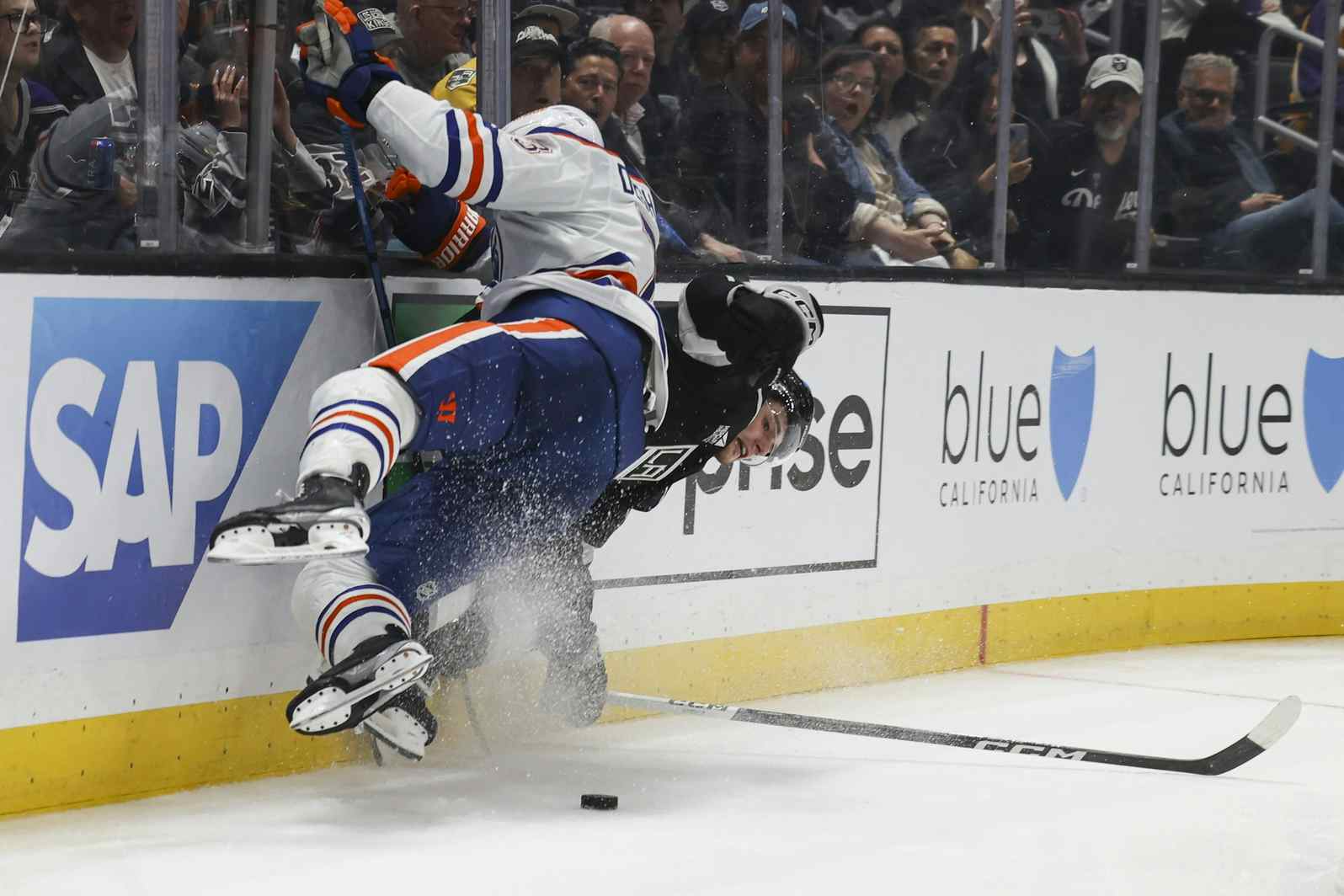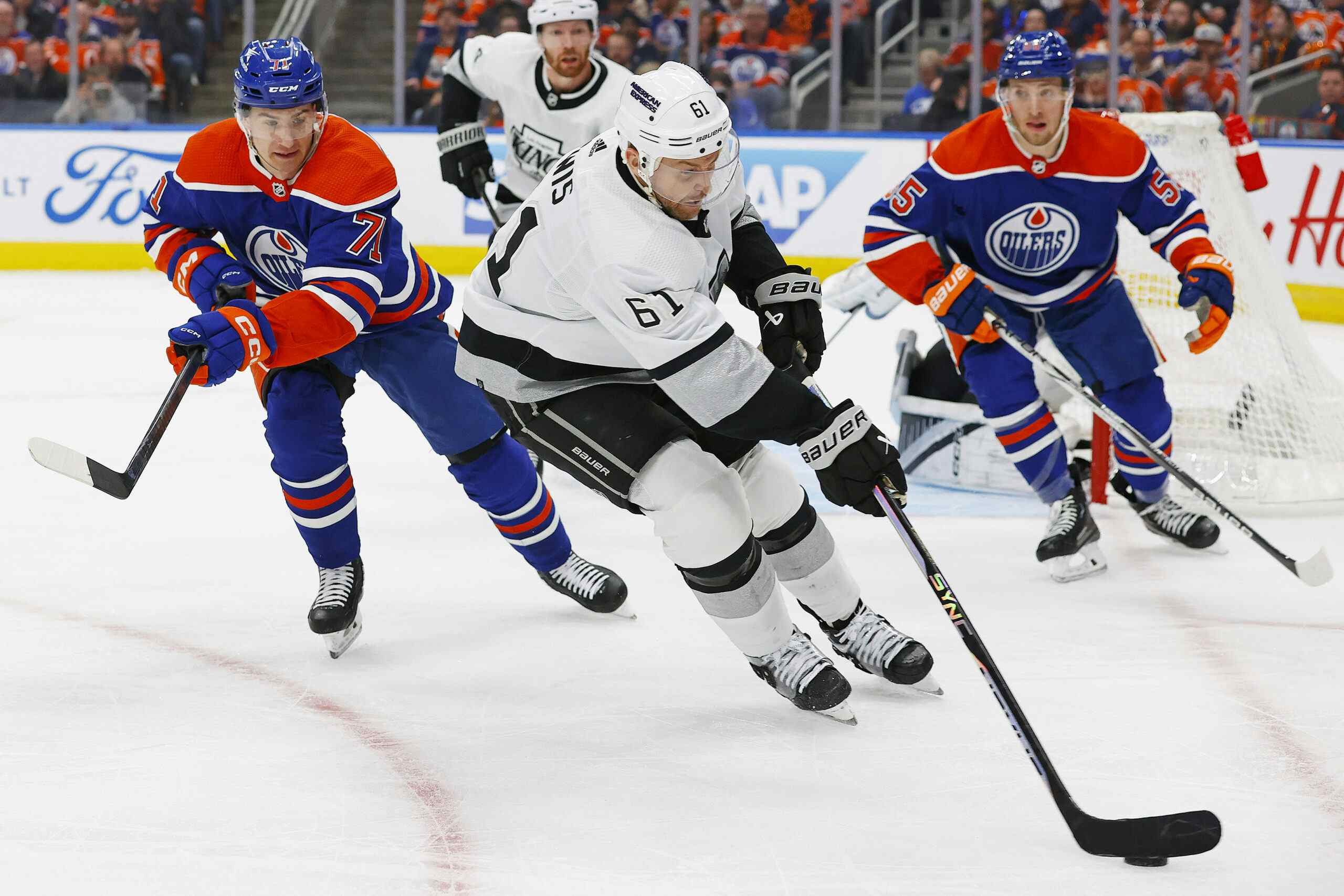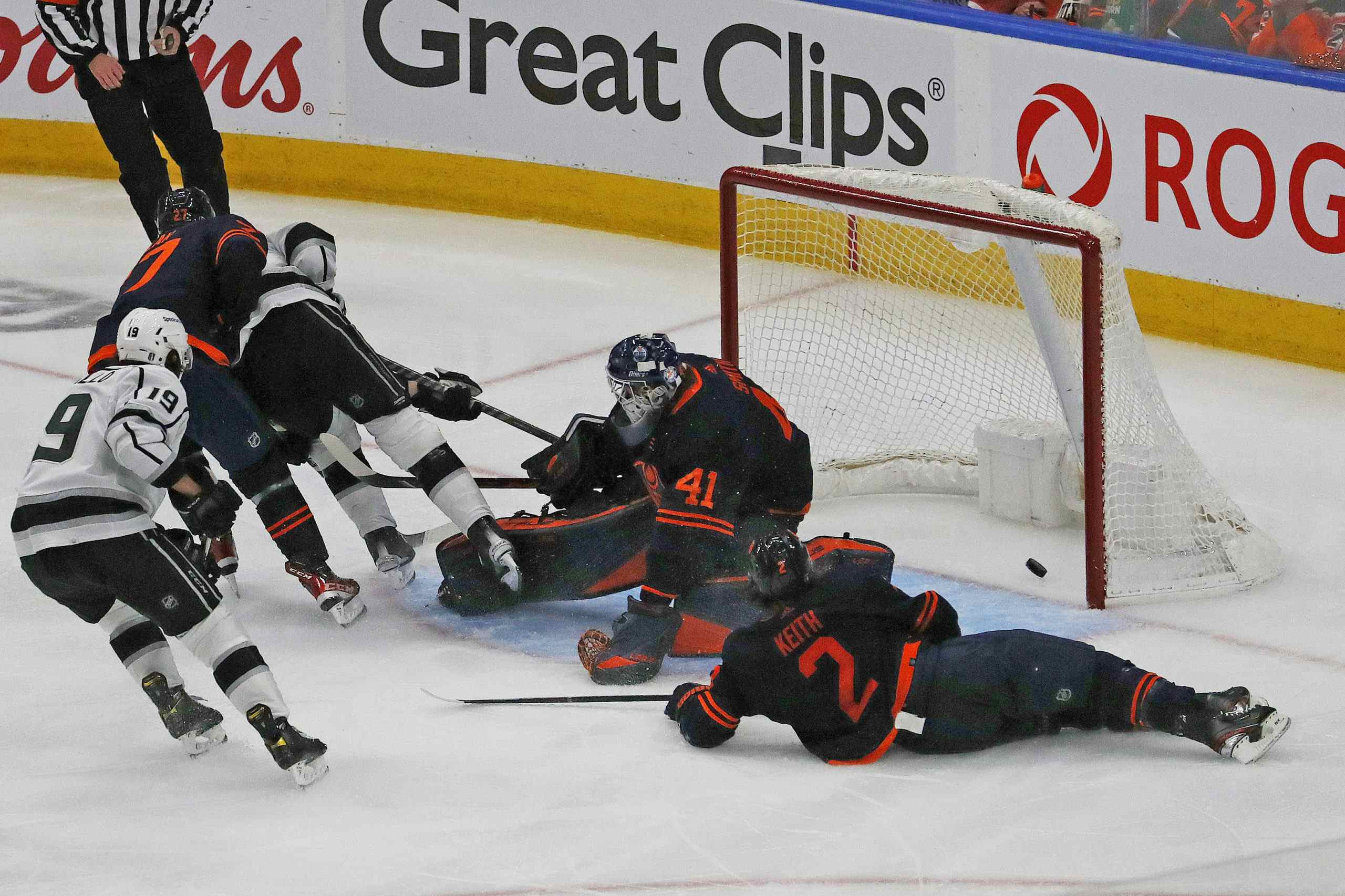Young Stars Tournament Day Three: Oilers evolved game hidden by score

The Nations Network sent some Jets Nation writers to the Young Stars Tournament in Penticton, BC. They’re judging your team and bringing you the view from the Press Box.
I’m back with more Oilers Young Stars updates from last night’s 7-2 loss to the Jets prospects. As a Jets blogger, I could really see my bias in this game. I often wrote notes that were ‘Jets player did x well’ rather than ‘Oilers player misread x.’ I suspect I missed some important details of the game from an Oiler fan perspective in that regard. Still, I hope what I saw spurs a conversation, and as always, I’m very interested to hear what you see on the stream that might have looked different. As before, systems followed by player reviews.
System and Team Play
I could see the evolution of the Oilers’ intended system on display in this game. The powerplay continued to feature a cherry picker in transition, but the entry was to the opposite side, with the high forward circling up and attacking as F2 through the middle upon entry. They used three different half-court powerplays to my eye, starting with the umbrella and switching to a more effective funnel in the third and using a box+1 on the 5-on-3. A few notes about that.
One, the box+1 is where the PP creates a larger box around the PK box and then puts one person inside the PK box. The point is to draw the PK box apart and feed the man in the middle. You might notice from the name box+1 that it is intended to defeat a box. It is not well suited to a collapsed triangle, since the most dangerous attacker is now covered by three players. It generated just a single chance when the Jets forward over pursued the wing and left Khaira open, but Khaira missed the top corner from the low slot.
Two, I’m sure it was obvious to all that the funnel in the third was a game changer for the Oilers special teams. It’s easy to recognize – three skaters along the blue line in free rotation to pull apart the top of the box and two skaters in front of the net, required to create traffic and perform puck retrieval. The Oilers only had one skill forward for each PP unit, so the tactic fit their personnel well. You might have noticed a similar play used by Detroit a few years back, where Zetterberg would play the high middle and could choose to accept or let through the pass to Lidstrom behind him, both primed for a shot. The Oilers prospects aren’t that advanced just 3 days into Rookie camp, but it was interesting to see some evolution.
They also evolved their PK in the neutral zone, using a 1-1-2 that flattened to a 1-3 if the up-ice pressure failed for force a lane for the Jets PP. They maintained a box against the Jets umbrella with limited effectiveness. You might have noticed the Jets had a lot of time at the top and along the sides of the zone.
At evens, the Oilers made huge changes, switching to a defensive collapse that closed the middle lanes Calgary has used to beat them. It meant the Oiler defenders backed down from the line and the Oiler forwards pursued contact and the puck less. In back check, they were tasked with moving through the middle lanes to a spot instead of tracking a particular man for man coverage. Cadorette was weak link, and the Jets have a talented group when given space. The Oilers also seemed more dedicated to the dump and chase, which backfired in the first because the Jets defenders are excellent puck movers at this tournament. One of the changes for the Oilers in-game was to back-off their second forechecker to float in the first outlet passing lane. The Jets defencemen were seen hesitating because in 3 days, they probably haven’t practiced more than a couple escape options. It gave the Oilers lead forechecker a chance to actually get on the puck and the Oilers had much more zone time in the second and third.
Defence
#60 Philippe Cadorette: If game one’s goat for the Oilers was Baddock, game two it was Cadorette. He was beat in every way a goalie can be – over the shoulder of his 5’11” frame a few times, five hole on a deke by Blomqvist, left flopping on the Petan goal. Shots when through him and around him, and when he got something on it, he didn’t have control of it. The Jets managed just 5 shots in the final frame, and Cadorette showed why prevention is the best medicine.
#78 Martin Gernat: Gernat fell back to earth a little in this game, and his blue line work for which I lauded him was good but unspectacular. Still had some excellent rushes with the puck and generally seemed offensive capable, through struggled to generate offence as he did in game one. In the defensive end, his struggles continued and worsened. He was prone to loose gaps in the first game, and against the Jets struggled to get his hands on anyone during play. The Jets swinging forward movement sometimes left Gernat looking like he was doing acceleration drills back and forth.
#80 Martin Marincin: Poor Marincin. Playing on his off-hand side again, changing partners from the limited by calm Betker to the frenetic Klefbom. Marincin looked better with the former. The change to the collapse system threw Marincin’s gaps, and he stopped closing lanes on forwards. Got beat by Kosmachuk because Klefbom was supposed to read the underneath lane and support in this system. Still got a stick on it, lucky whack by 72 blue. Had some odd plays. Weak shot to nowhere in 1st, unforced give away on PP in 3rd.
#82 Joey Leach: Skating is below average for this level, and his first period was spent trying to do too much and chasing the play. Give away that led to first goal was an example. Calmed his game in periods 2 and 3, trusted Musil more, and kept the play in front of him. Had a couple opportunistic rushes. A bottom pairing guy in this tournament.
#84 Oscar Klefbom: There are few players I’ve been more confused by than Klefbom. I think we have to call it a bad game, and certainly rust and moving to the small ice could easily be factors. Moved to the left for this game, he continuously rotated to the right – the opposite behaviour he showed in game one. He stood up Lukas Sutter in a 1-on-1 in the first after Marincin had given Kosmachuk space, and won the puck battle. Great break-up against the Jets fast break in the 2nd. In the third, pursued closely by a Jets forward, he skated full speed at his own end boards and executed a stop/turn/escape with a level of power and control not seen at this tournament. The Jet just had to turn past him as though a boat on water in comparison. His skating is elite for this level. His rushes were effective and dangerous. He had a few shifts in which he put together a defensive stop, transition play, and offensive attack in which it was impossible to deny his talent as a 1st round selection. He was also a defensive mess, chasing the puck all night and confusing Marincin to no end.
#87 David Musil: David Musil is making it hard to imagine him as an NHL player. His skating is below average in this tournament, and it’s a problem. Still – I thought he had another good game. Maybe the only Oiler defender to never get confused by the Jets forward movements/rotation. Kept the play in front of him for the most part, despite mobility issues. Active stick, read passing lanes well. In the half-court, he’s rigid but effective. In transition he needs a lot of support.
#88 Brandon Davidson: The Oilers best player for much of the game. His shots were through traffic and on target all night. Great gap in transition – much tighter than most Oilers – and obvious awareness. Patient at both ends of the rink. Extensive powerplay time and one of the few lights on the unit until the Oilers moved to the funnel in the 3rd. Skating is very high level, though shy of Klefbom and Nurse still. Got beat on a Petan move at the blue line 2-on-2 in which Petan drew him in with a change of pace. Davidson made a swift attack but it was telegraphed. One of a few hesitations in the game, possibly because of loose systems and new team mates.
Forwards
#39 Brandon Baddock: A much improved effort, showed good vertical speed and used his big 6’3” frame to get involved along the boards. Still a bottom end forward in this tournament, but nice to see how he got the invite.
#42 Marco Roy: A standout for the Oilers and just about the only consistent offensive threat. A strange line for him with Fyten and Houck meant he was often alone trying to create. Still was able to carry his line with outstanding two-way play and anticipation. Skating is above average, but not plus – quick but not powerful. Puck skills are very strong. The only Oiler forward to look comfortable on the powerplay. I think we might talk about him differently in this tournament if he had better linemates.
#47 Ty Bilke: Somehow Bilke was given an ‘even’ in the game sheet while his line mates were -2. I can’t go back and track that, but something tells me he was maybe fighting someone on the bench or checking the peanut vendor when the goals were scored. Bilke took his role very seriously on the All Violence Line, and even fought the Jets most invisible player, Jean Dupuy. Threw a huge hit on Adam Lowry after Lowry cleared on the PK in the third. Hit all the faces he could find when Roy was mugged in front of the net. His vertical speed is good and his approach speed to hits is high, meaning he’s likely thinking about them well in advance of the play or organize his angle. Shows focus and hockey sense. Was not particularly good with the puck or at supporting it, but certainly frustrated and angered the Jets.
#49 Kale Kessey: I think Kessey managed to hit every sponsor name on the boards in the whole rink. Maybe he’s after an endorsement deal. He did have some good moments, forced several turnovers by the Jets defencemen (who did not like to be hit), and looked good in front of the net on the powerplay. Good puck retrieval in the offensive end. His skating is not an issue at this level and he gets around the ice well. Clearly had the Jets thinking about him. Replaced some of Houck’s minutes after the injury and looked better with Roy than did Houck. Will have to add more hockey skills to move up levels, but has all the energy and recklessness an exhibition tournament can handle.
#52 Austin Fyten: Appeared often throughout the game. Threw a number of open ice hits and was credited with 5 shots officially (though I’m not sure about a game sheet that gives Davidson just one shot on goal). Was a bit confused by Roy’s more creative use of the zone and could be seen standing still on occasion. He’s active and reacts to the play well. Anticipation is limited, and that’s most obvious on the powerplay where he didn’t know how to use movement to set up future plays.
#54 Jujhar Khaira: Another strong game for Khaira in many respects, but also a more conservative one. Less often seen on the offensive end boards, and the collapse helped him be less exposed defensively. A bad pass to Miller in front on a chance I bet Miller gets blamed for in 3rd. Missed chance on 5on3. The chaos he creates can lead him to chasing and his legs wore out on one play chasing back and forth. Has high-level anticipation as shown by his offensive positioning, but gets over-excited when defending and starts to chase. Needs more time in my opinion.
#58 Andrew Miller: A disappointment so far this tournament, given where he was expected to be as an over-age player with NHL hopes. The Oilers third best forward with the puck, but that puts him very low in the tournament. His two-way play is there, but not exceptional. Roy and Petan both do more with even less size. Relied upon as one of the few Oiler skill players and I think it’s reasonable to put some of the Oilers lack of scoring on his shoulders as a result. Puck skills are good, missing that scorer’s instinct so far (it is a rookie camp, mind you). Gives up on plays that aren’t going well, such as the Khaira pass to his skates.
#61 Jackson Houck: An ugly hit by Morrissey. Really an awful way to exit a supposedly friendly tournament. Was the third player on his line with Roy and Fyten, but it’s hard to say too much hockey related about a guy who was happy to be able to walk and talk last night. He says he’s concussion symptom free, with only facial injuries to show. We can hope it stays that way.
#67 Travis Ewanyk: The Oilers worst forward by a country mile. Twice (at least) in which he went to his position to receive a transition pass and then just didn’t notice that the play was coming to him. It was mind-boggling that he not only missed a pass (okay, that’s about organizing your body), but that he went to the right place and didn’t even know he was in the play. The first part (going to the right place) is coached. The second part showed a stunning lack of hockey sense. We’re left to wonder what would happen if the Oilers turned the puck over. Would he have just continued up ice? What did he think was happening? Apart from those two plays, he mostly played out-of-position goon, and was worse at it than Kessey or Bilke. In two viewings, I just don’t see how Ewanyk can be considered a defensively minded hockey player considering his lack of focus and attention to the play around him.
#71 Kyle Platzer: A very pleasant surprise for the Oilers, and their second most dangerous forward after Roy. Strong positioning throughout the game, great sense of the net, used his teammates well. Not a high level skater for this tournament to my eye, but was against an exceptionally mobile Jets defence. Another viewing is necessary.
#76 Chase Schaber: My first note on Schaber was that he was playing less time away from the puck covering for his linemates and more time at the puck trying to make an impression. To me, that’s why he was so much more noticeable to start the game. But then it continued, and he showed offensive skill in a few high quality chances. He drove the net, he caused turnovers, and he won faceoffs and back checked through passing lanes. Very good game for Schaber. Perhaps just the nature of a tournament like this, but not sure why he didn’t get moved around to more skilled lines.
#96 Greg Chase: Another solid outing for Chase, who has been a quiet but effective player for the Oilers. One play in the third where he stood stationary against the boards on the breakout, and then let the pass bounce off his skate and into the middle ice without moving for it. A lapse? Tired legs or brain? One moment didn’t overshadow the fact that he continues to play a possession style and use his line mates very well.
Recent articles from Kevin McCartney





